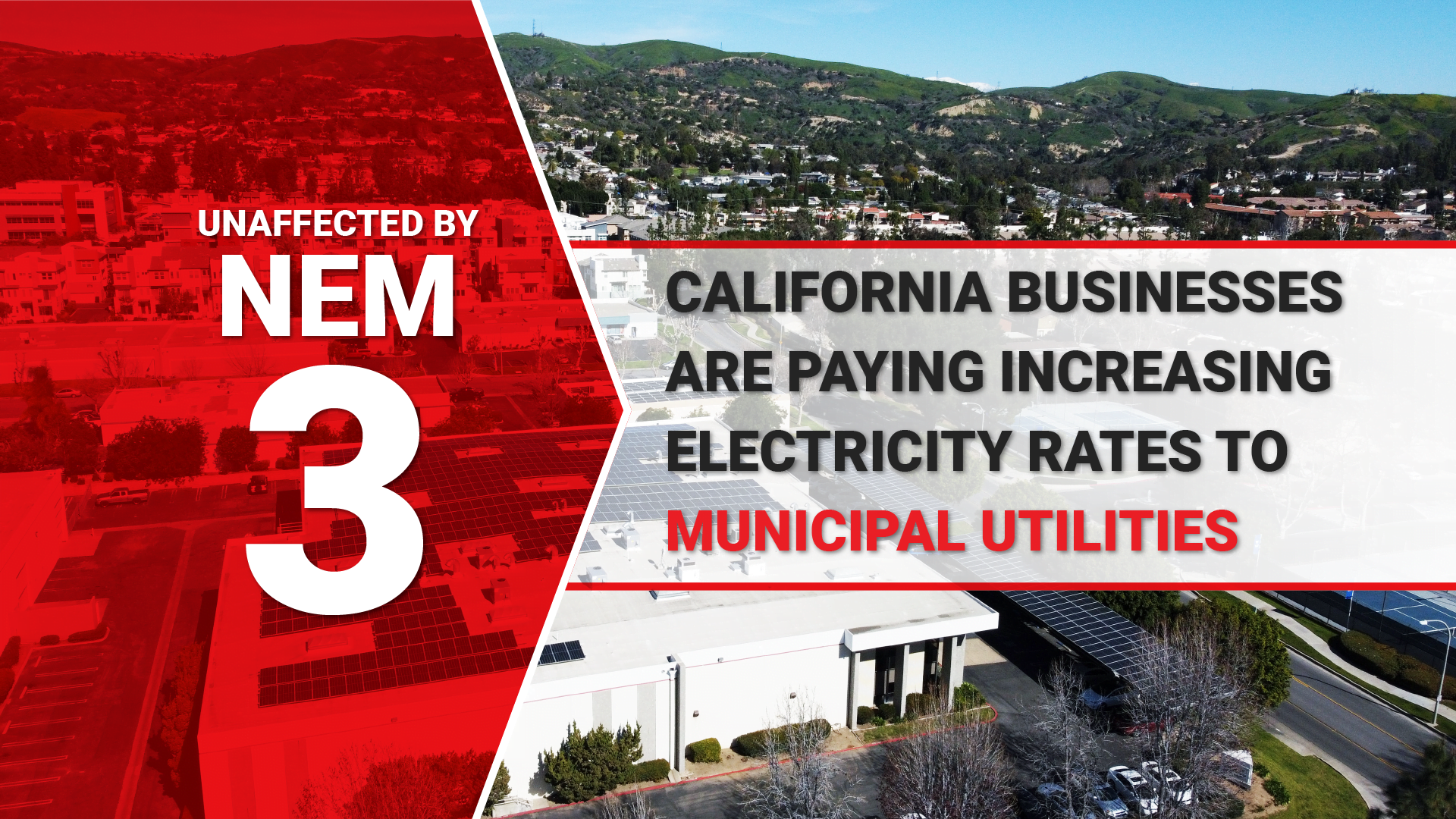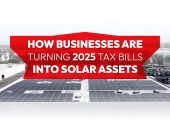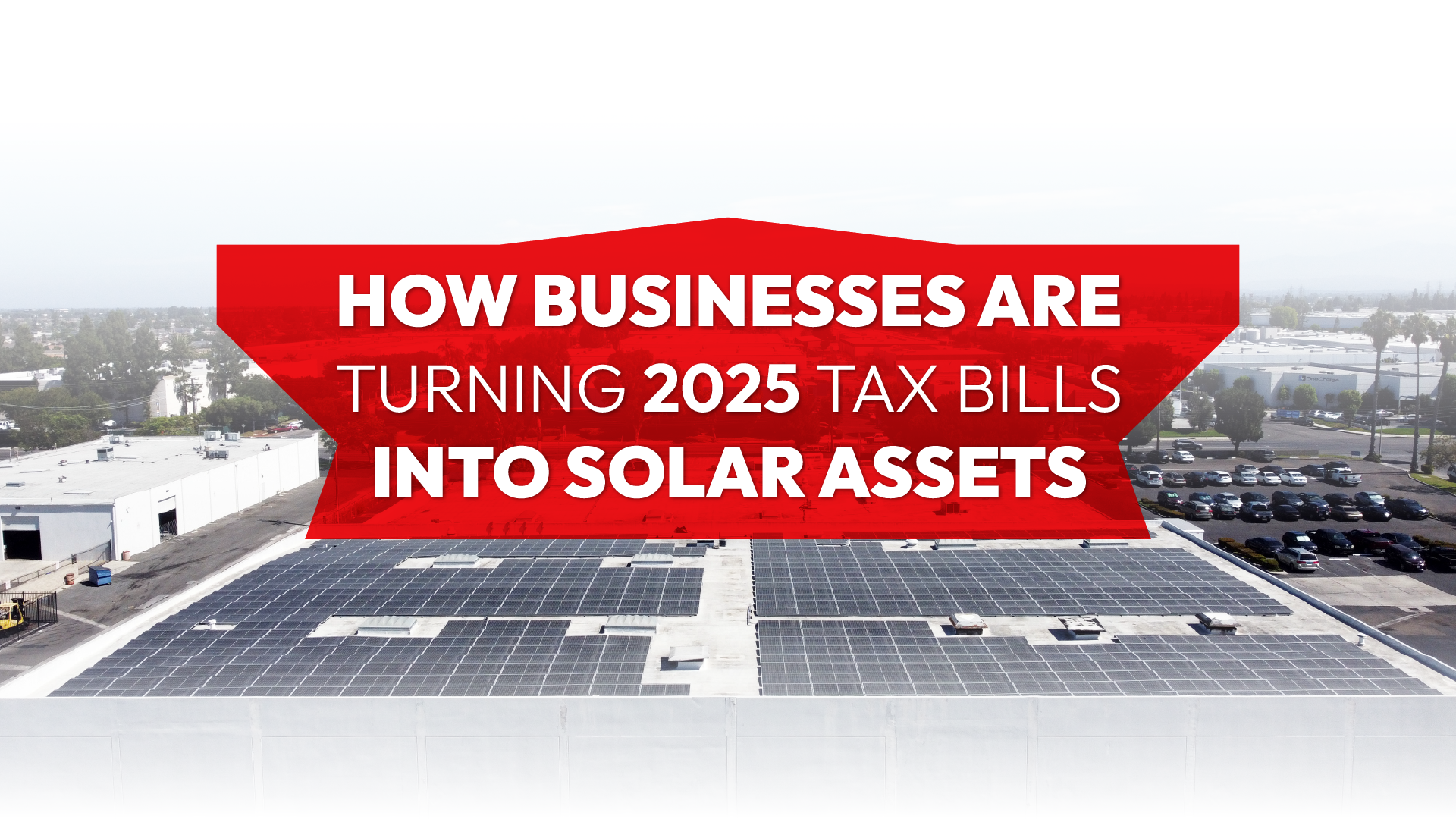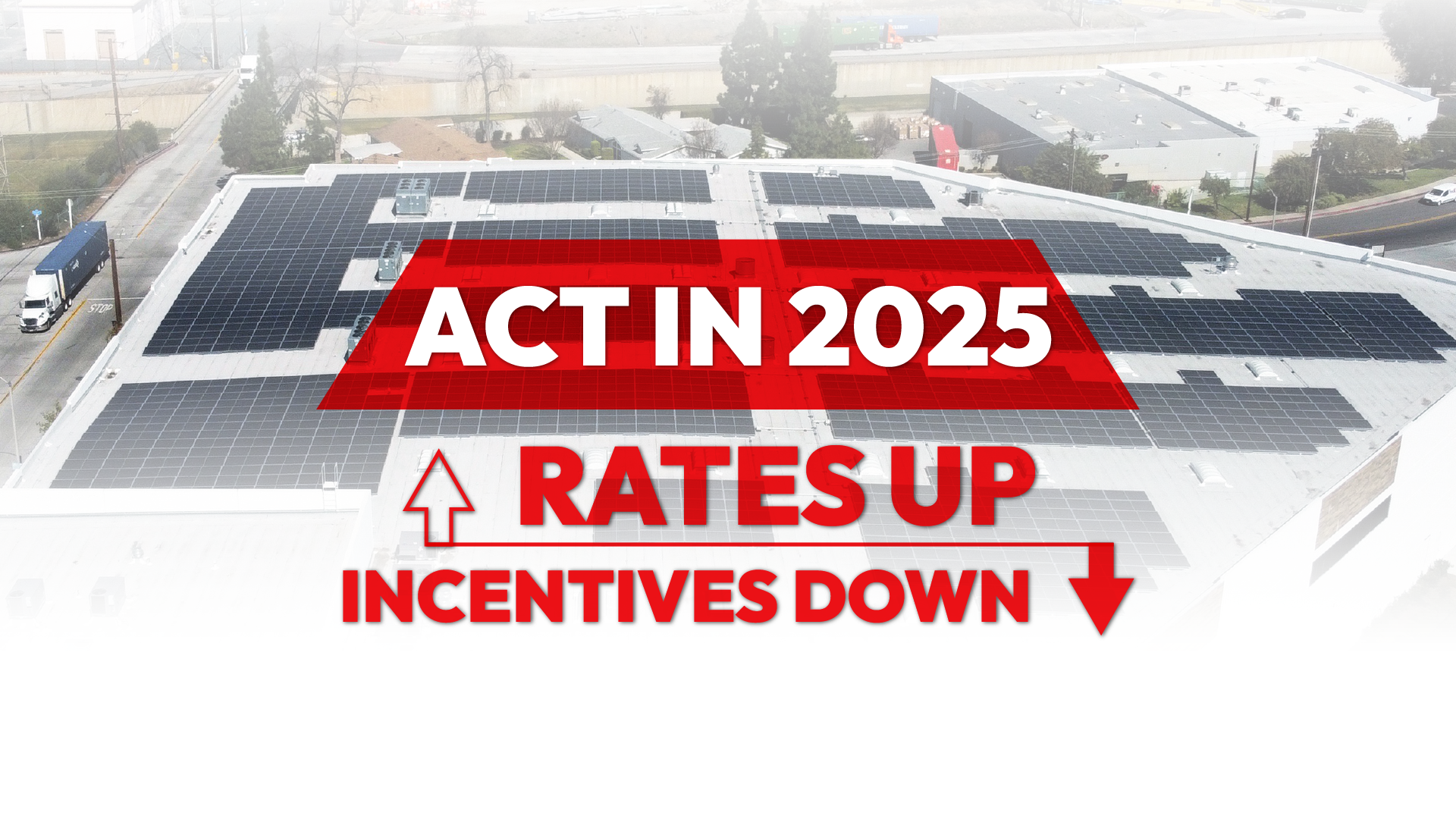California Businesses Paying Increasing Municipal Electricity Rates While Unaffected by NEM 3
Many electric load-serving entities, like municipal utility providers, are unaffected by the sweeping changes of NEM 3 implemented by the CPUC for California’s Investor Owned Utilities (IOUs) – but they still continue to pay constantly increasing electricity rates. Dynamic energy solutions like commercial solar paired with energy storage can help these businesses create significant cash flow by using electricity bill savings to pay for their facility investment.
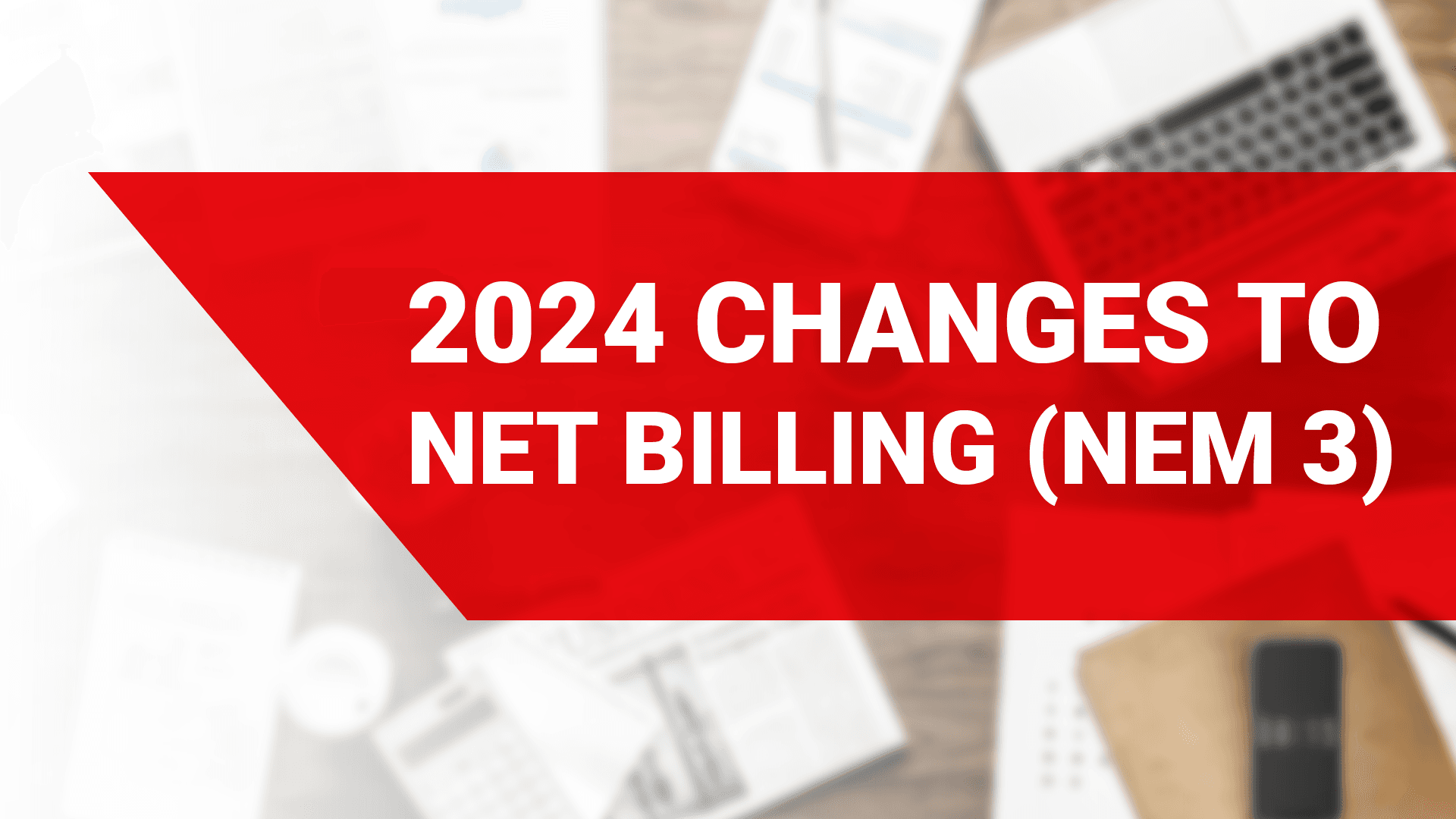
Electricity Rates Rising for All Utility Providers
As we covered in our previous study, 2023 electricity rates for investor owned utilities in California are rising faster than other utility providers. While dependent on location, there can be alternatives to IOUs available like community choice aggregators, municipal publicly owned utility providers and direct access electric service providers. These entities often set their own net metering rules and don’t observe the changes made under NEM 3, but are often regarded as a more cost effective electricity provider than IOUs like SDGE, PGE and SCE.
However, all electricity providers have been seen increasing costs to keep up with market rates set by the CPUC for these IOUs. In a previous study, our team learned that businesses in the 3 major IOU territories saw their electricity costs increase by as much as 68% just from 2019 to 2023.
Wanting to further understand how much more businesses in California might be paying for electricity, our team took a look into different electric load-serving entities, like municipal providers, and how their prices on commercial, industrial and agricultural energy customers have increased over the past few years. As we discovered when we studied the big 3 investor-owned utilities, businesses are paying rapidly increasing rates that don’t show any signs of slowing down.
Electricity Rates for Businesses with Municipal Utility Providers
Some cities in California operate their own utilities to businesses within their jurisdictions, these are municipal utility providers. As they are more accountable locally than IOUs, they often offer lower electricity rates comparatively. Here are some California cities that keep their own publicly owned utility providers; Anaheim, Burbank, City of Industry, Corona, Imperial, Los Angeles, Modesto, Pasadena, Riverside, Turlock, Vernon and more.
Municipal Electricity Costs - Los Angeles Department of Water & Power (LADWP)
This graph represents the annual electricity costs for a commercial business in Los Angeles, paying the LA Department of Water & Power (LADWP) for their electricity. Just from January 2019 through January 2023, our team collected data from one of our customers to learn over that short period of time this businesses electricity costs had increased by 25%.
Looking to mitigate these consistently rising costs, this business was highly motivated to seek out alternative solutions like solar and energy storage to eliminate the cost uncertainty that cast a shadow over their bottom line. This business quickly contacted Revel Energy for a free obligation-free quote from our expert team.
This LA commercial property was prompted by their fast-rising bills from LADWP, but a competitor in the area proactively installed solar to mitigate these significant cost increases.

Anaheim, Riverside & Vernon Public Utility
Municipal Providers Increasing Commercial Electricity Rates
Municipal public utility providers are established in cities like Anaheim, Riverside and Vernon and are offer cost-effective electricity rate alternatives to California’s second-largest investor-owned utility, Southern California Edison. SCE is also on a high rate trajectory as we found in this and our last electricity cost case study on a similar rate plan for a commercial manufacturer. SCE serves almost 5 million customers as the largest subsidiary of Edison International.
Tracking a manufacturing facility from June 2019 through January 2023, this Anaheim Public Utilities customer was spending 24% more on electricity bills in 2023. An annual average rate increase of almost 6% was drastically mitigated by the business installing a rooftop solar system, supported by energy storage, that started producing electricity at the beginning of 2020.
For a more perspective, the graph below are other commercial businesses in Riverside and Vernon that spend significantly more on energy, both saw similar increases that seemed to land in 2022. Even for municipal utility providers like Los Angeles, Anaheim, Riverside and Vernon, these increases are rising past the expectations of financial planners and requiring businesses to take quick action to mitigate spending even more on electricity in the future.
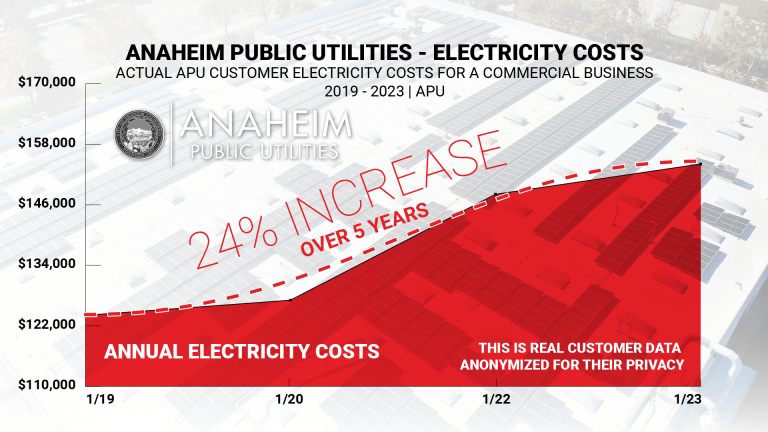
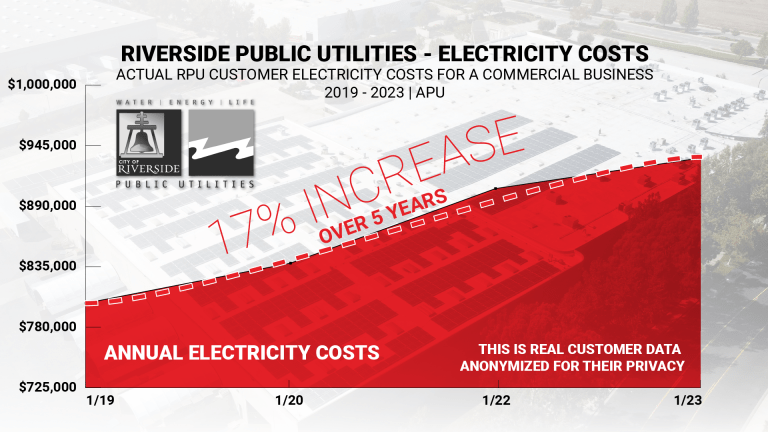
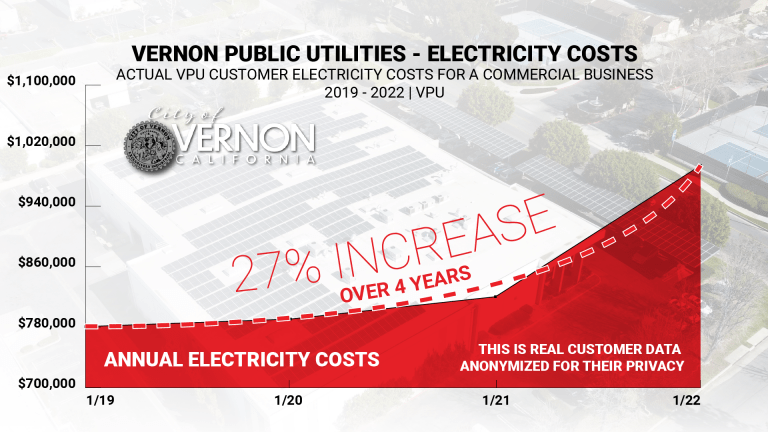
Agricultural Electricity Costs Increasing for Imperial Irrigation District (IID) Customers
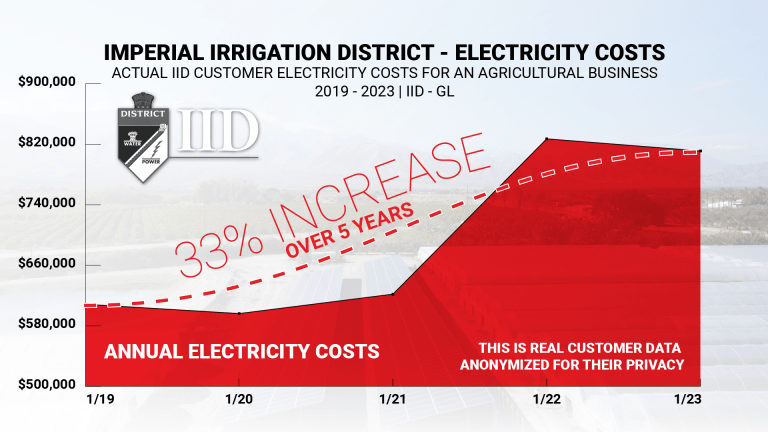
Not just commercial and industrial, but agricultural businesses like those served by the Imperial Irrigation District may be feeling the effects of municipal rising energy costs more than most. Thankfully the increases aren’t as intense as seen by some Pacific Gas & Electric customers, but still significant as businesses still look to double what they spend on electricity in the next 10 years.
Following the trend of other municipal providers above, this business had been paying much higher electricity bills in 2022, followed by brief respite so far in 2023. Over the recorded 5 years, this agricultural business saw their bills increase by 33%. As a result, this business was urged to seek other options, like investing in solar plus storage for their facility by contacting our expert team for an energy consultation for their business.
Costs for Businesses with Direct Access Energy Providers or Community Choice Aggregation
Exclusively for non-residential customers, direct access (DA) allows businesses to access electricity directly from an independent supplier rather than an IOU. DA customers typically pay a higher rate compared to IOU customers, but still save money in the end through the ability to work with the electricity provider to optimize when and how energy is consumed.
Community Choice Aggregation or CCAs are locally governed not-for-profit entities that purchase power on behalf of its assigned residents and businesses. CCAs typically offer lower rates than IOUs since most of the supply is provided by renewable energy technologies like commercial solar and energy storage.
Why Are California’s Electricity Costs Increasing in 2023?
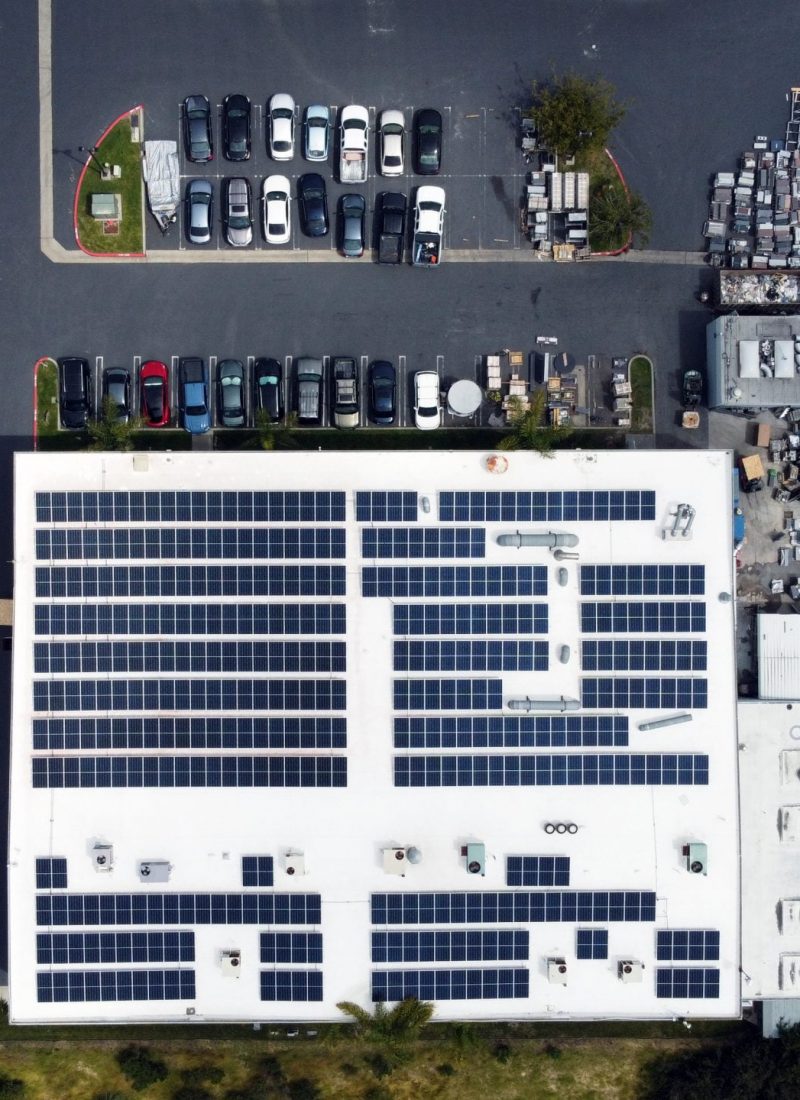
One source of California’s rising electricity costs for businesses in 2023 is the state’s ambitious clean energy goals, which have led to the closure of several fossil fuel-powered power plants and an increased reliance on renewable energy sources such as solar, energy storage and wind. While these sustainability efforts are commendable from an environmental standpoint, they have also led to a tighter supply of electricity, which causes utilities to increase their rates. Natural gas is also facing serious price hikes as high as 300% in January 2023, prompting Governor Gavin Newsom to call for a federal investigation on the price spike. This unfortunately also pushes up electricity rates since gas provides more than 50% of the state’s electricity demand.
Another significant factor that contributes to the rising cost of electricity in California is the state’s transmission and distribution infrastructure. The state’s electrical grid is aging and in need of upgrades and expansion, which will be very costly. Revenue requirements for these investor-owned utilities have put pressure on rates and infrastructure costs, potentially slowing the overall effort to modernize the grid.
California’s big 3 investor-owned utilities, Southern California Edison, San Diego Gas & Electric and Pacific Gas & Electric recently won a battle against California’s solar industry where new projects after April 2023 receive significantly less value for excess solar energy exported to the grid. Utility providers across the globe are acting quickly to find ways to meet drastically increasing demand as more fossil fueled energy sources are electrified.
Businesses Facing Lost Opportunity Cost by Waiting
While some businesses wait to decide what to do with their increasing electricity bills, their competitors are slashing their operating costs by generating their own electricity through commercial solar and energy storage. Electricity rates will continue to climb for all utility providers; IOUs, municipal, CCA, and even direct access providers as dictated by the demand of all of California’s growing industries.
Upcoming changes to the 2023 energy code will require commercial building retrofits to include solar and storage solutions. Also for future consideration, depending on the size of a commercial or industrial solar installation, new rules defined in the updated Solar ITC may require larger projects to follow prevailing wage requirements to take a higher value tax credit. In a situation where a business is still on a NEM program with their utility, new rules demand prevailing wage requirements be met as the project is considered “public works” by interconnecting through NEM.
Revel Energy offers California businesses the opportunity to step into true sustainability, contact our expert team today to learn if your business can take advantage of a commercial solar and energy storage solution.
Commercial grade rooftop solar is ideal for: manufacturing, warehousing, logistics, industrial, retail, hospitality buildings and more with over 10,000 sq. ft. rooftops.
CARPORT SOLAR
Free standing carport solar generates added solar power for properties with limited rooftop space. Added benefits include shading and protection for employees vehicles.
Crucial for reducing peak demand charges. Automated to supply electricity when your panels won’t. Energy storage is ideal for businesses that incur significant peak charges.
As the popularity of electric vehicles increase, so does the demand for on-site charging. This sustainable amenity has become a parking lot fixture for competitive employers.
OUR SERVICES
TURNKEY COMMERCIAL GRADE SOLAR, ENERGY STORAGE, LED LIGHTING AND MORE.
PROFESSIONAL GUIDANCE
CUSTOM TAILORED PLANNING
CONSTRUCTION & INSTALLATION
CSLB #1106092
Client Testimonial: Kelemen Company
Corporate Business Park in Irvine, CA has created significant electricity cost savings through commercial solar installed across the 5-building business park.
Client Testimonial: Tice Gardner & Fujimoto LLP
See how this CPA firm saved on electricity and gained valuable tax credits through commercial solar that they used to keep cash in the businesses.

